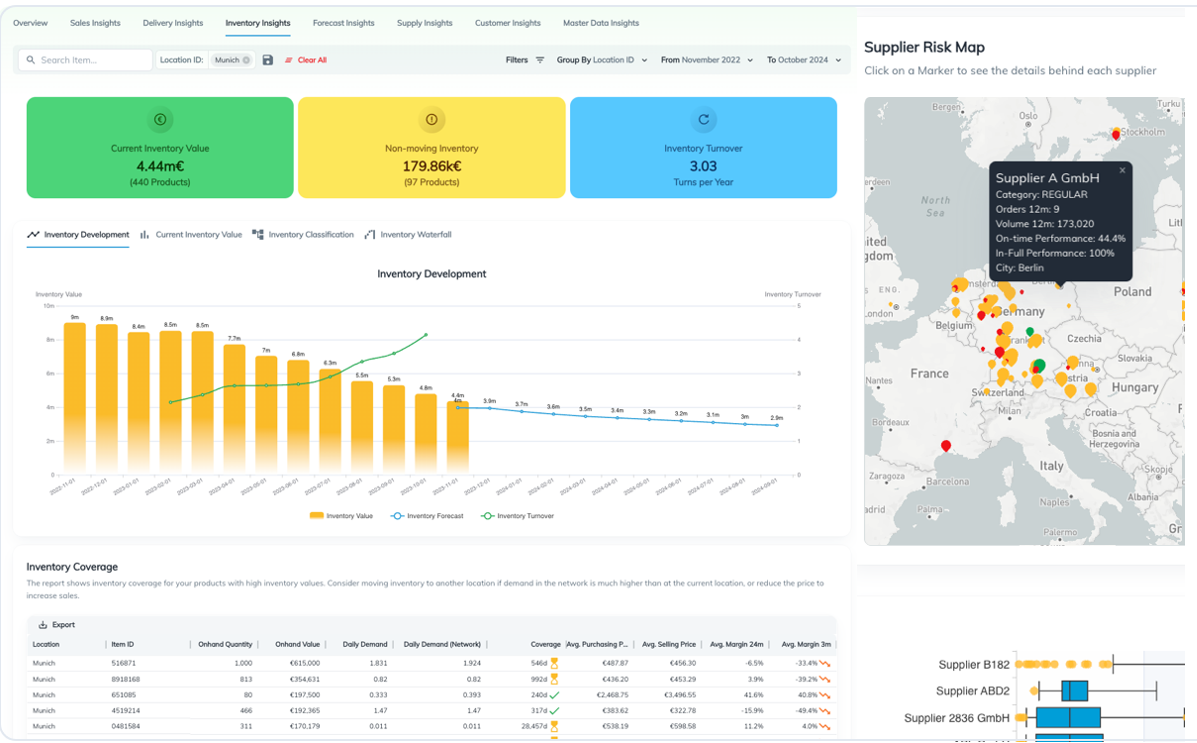
The Inventory Management Software for Your Supply Chain

Stefan Gaubatz
31 Oct 2025
The Inventory Management Software for Optimal Stock Levels
The Numi Inventory Management Software helps buyers and planners position the right stock at the right time in the right place.
In many companies, static inventory parameters, inaccurate lead times, and fixed lot sizes lead MRP runs to produce either shortages or excess stock.
Traditional ERP systems rarely allow users to simulate or optimize the effects of lead times, target service levels, or order frequencies. They also lack integration of AI-driven forecasts into replenishment planning.
The Numi Inventory Management Software solves exactly these challenges: algorithms automatically optimize inventory parameters, calculate real lead times, and generate transport-optimized purchase proposals that can be seamlessly written back to your ERP system—so purchase orders are created automatically.
Results Achieved with Numi Inventory Management Software
- Up to –15% less inventory through AI-based optimization
- Up to –10% fewer stockouts thanks to accurate lead-time and replenishment planning
- Up to 4 hours saved per buyer per day through automation and intelligent recommendations

Numi’s Inventory Management and Optimization Features
- Automated purchase proposals: Daily cost-optimized ordering suggestions.
- Optimal inventory parameters: Dynamic daily optimization of safety stock, reorder points, and lot sizes.
- Lead-time forecasting: AI-based calculation of actual supplier lead times.
- Inventory scenario simulation: Analyze “What does +3% service level mean for my stock development?”
- Inventory forecasts: Historical and forward-looking inventory trends.
- Optimal stock segmentation: Automatically validate and adjust classifications and ordering segments.
- Automatic ERP synchronization: Update parameters and lead times directly in your ERP system.
- Daily recommendations: Reallocations, shortage alerts, and shelf-life warnings.
- Real-time inventory reporting: KPIs across all levels – retrospective and predictive.
- Inventory health dashboard: Full visibility into bottlenecks, overstock, and risks.

Transparent and Collaborative Inventory Planning
With the Inventory Management Software, planners and buyers can proactively identify products approaching end of life, detect overstock situations, or track items nearing expiry.
Dynamic inventory segments enable the simulation and financial evaluation of different inventory scenarios—such as varying order frequencies, lot sizes, or target service levels.
This transparency allows companies to analyze the impact of every decision and create a unified, data-driven planning process across all departments.

Optimal Inventory Planning Parameters
The software detects deviations between ERP parameters (e.g., safety stock, reorder points, or lead times) and the optimal values per SKU.
Based on this, Numi provides daily prioritized recommendations that can be synchronized to your ERP system with a single click.
Additionally, the Inventory Management Software generates transactional recommendations—such as reallocation or order adjustments—that support operational decision-making, help reduce global stock levels, and improve supply performance.
Intelligent Inventory Management Powered by AI
The Numi Inventory Management Software combines AI algorithms, simulations, and automation into a modern solution for achieving optimal stock levels at minimal cost.
Planning, procurement, and supply-chain teams work seamlessly together—resulting in measurable service-level improvements, lower inventory values, and faster decision cycles.